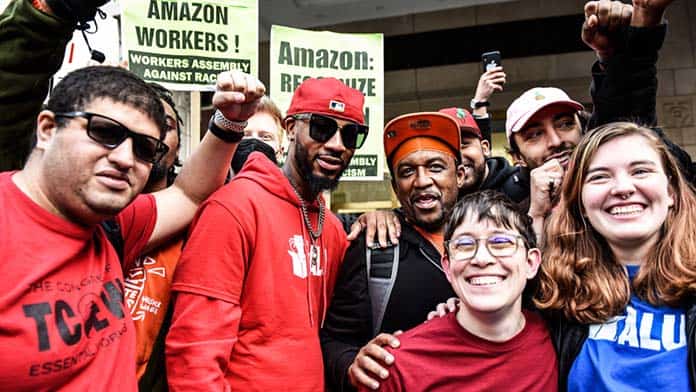“We want to thank Jeff Bezos for going to space, because while he was up there we were organising a union,” the president of the newly formed Amazon Labor Union (ALU), Chris Smalls, told reporters after their spectacular victory in Staten Island, New York.
Workers at the JFK8 Amazon warehouse have become the first Amazon workplace in the US to unionise, in another example of workers in the US fighting back following the pandemic.
The historic win was a true David vs Goliath battle, with the ALU—a newly formed union run by current and former Amazon workers—taking on the country’s second largest employer and the second richest man on the planet.
But the win was no fluke. It was the result of hard organising work that is ripe with lessons for workers everywhere on how we can build union power from the bottom up.
The union push began when Smalls was fired for organising a walkout at the warehouse over COVID safety in 2020. He continued organising with workers there from the outside.
The bus stop outside the facility soon became the hub of ALU organising, with a core team of mostly young workers intercepting workers on their way home. Here they provided food and spent endless hours talking union, distributing material and building relationships with their co-workers.
What is remarkable is that the campaign was run entirely by rank-and-file workers. They used Gofundme to cover costs and found a pro bono lawyer through Twitter. Smalls remarked, “All I had was 20 core committee members and a workers’ committee of over 100 people. We started with about four.”
Smalls’ apartment was the site of an extraordinary phone contacting operation, where hundreds of workers were called every day in the lead up to the vote, with the help of volunteers from various unions and left groups.
Break rooms at the warehouse also became key bases for union activity. Activists would spend up to 12 hours a day in the break rooms handing out leaflets, giving out food and talking to workers. It took incredible dedication.
One of the organisers, Angelika Maldonado, explained, “Those of us on the committee were in the building seven days a week, 24 hours a day. Even on our off days we were in the building—after I picked up my son from school and it was my off day, I always headed straight to the building.”
Working conditions at Amazon are notoriously brutal, with workers on wages that they can barely live on and regular shifts of ten or 12 hours. The company imposes restrictive controls on workers, refusing to allow them to sit down all shift, limiting breaks and monitoring the time workers take to go to the bathroom.
Union busting
The union victory is all the more impressive considering Amazon’s colossal union-busting operation. The company covered the warehouses in anti-union posters. This was coupled with a website and social media campaign, as well as “captive audience” meetings workers were forced to attend with presentations on the dangers of joining a union. Millionaire “consultants” paid thousands of dollars a day were flown in to lobby individual workers.
The ALU took this head on. They stood firm against threats of retribution in captive audience meetings to insist they be allowed to argue their side. They gathered information on the consultants, compiling dossiers that allowed them to argue these were “rich people convincing poor people to stay poor”, as Smalls put it.
They exposed the consultants on social media, followed them around to catch every worker they talked to, and took them to court over intimidation and threats. Amazon was forced to sign a national agreement not to retaliate against workers trying to organise.
Amazon tried to tell workers the union was a harmful “outside influence” and would take their money through union dues. The democratic, worker-led nature of the ALU demolished those claims.
Amazon used racist propaganda to depict the predominantly black unionists as “thugs” and drug-dealing criminals and tried to divide the workforce. But the ALU drew in organisers from among all the diverse ethnic and migrant backgrounds of workers at the facility, circulating material in a range of languages and holding street kitchens with different national cuisines as part of the organising effort.
Since the win, workers at more than 50 Amazon sites across the US have contacted the ALU for help. Another warehouse at the same complex on Staten Island will vote on joining the union on 25 April.
And the effects will be felt much further than Amazon. The ALU members at JFK8 have shown workers everywhere that it’s possible to defeat the mightiest of enemies. They’ve shown that if we organise ourselves, we can win.
By Cooper Forsyth






